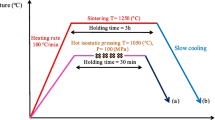Abstract
The study is focused on the machined surfaced integrity of TB6 titanium alloy (Ti-10V-2Fe-3Al) after dry milling with carbide end mills of variable helix, variable pitch as well as conventional geometry. Roughness, residual stress, nanohardness, and microstructure alterations are investigated. The results show that not only the cutting speed and feed but also the geometric structure parameters of milling cutters have influence on the surface roughness and residual stress. Nanohardnesses exhibited inconsistent variation from the machined surface to bulk material. Plastic deformations and defects are detected in the machined surface. The deformation twins impact the anisotropy, the hardening effect, and the plasticity of TB6 titanium alloy machined surface.
Similar content being viewed by others
References
Ezugwu EO, Wang ZM (1997) Titanium alloys and their machinability—a review. J Mater Process Technol 68(3):262–274
Boyer RR, Briggs RD (2005) The use of β titanium alloys in the aerospace industry. Journal of Materials Engineering & Performance 14(6):681–685
Rahman M, Wang ZG, Wong YS (2006) A review on high-speed machining of titanium alloys. JSME Int J 49(1):11–20
Ulutan D, Ozel T (2011) Machining induced surface integrity in titanium and nickel alloys: a review. Int J Mach Tools Manuf 51(3):250–280
Trent EM, Wright PK (2000) Metal cutting. Butterworth-Heinemann Press, Oxford
Jawahir IS, Brinksmeier E, M'Saoubi R (2011) Surface integrity in material removal processes: recent advances. CIRP Ann Manuf Technol 60(2):603–626
Daymi A, Boujelbene M, Amara AB (2010) Surface integrity in high speed end milling of titanium alloy Ti-6Al-4V. Materials Science & Technology 27(1):387–394
Paulo Davim J (2010) Surface integrity in machining. Springer, London
Zhao Q, Qin X, Ji C (2015) Tool life and hole surface integrity studies for hole-making of Ti6Al4V alloy. Int J Adv Manuf Technol 79(5):1–10
Houchuan Y, Zhitong C, ZiTong Z (2015) Influence of cutting speed and tool wear on the surface integrity of the titanium alloy Ti-1023 during milling. Int J Adv Manuf Technol 78(5–8):1113–1126
Rotella G, Dillon OW, Umbrello D (2014) The effects of cooling conditions on surface integrity in machining of Ti6Al4V alloy. Int J Adv Manuf Technol 71(1):47–55
Safari H, Sharif S, Izman S (2015) Surface integrity characterization in high-speed dry end milling of Ti-6Al-4V titanium alloy. Int J Adv Manuf Technol 78(1):651–657
Lei MK, Zhu XP, Li YP (2015) Significance of surface integrity on high-performance manufacturing by surface modification. Int J Adv Manuf Technol 82(9):1–12
Yao CF, Tan L, Ren JX (2014) Surface integrity and fatigue behavior for high-speed milling Ti-10V-2Fe-3Al titanium alloy. J Fail Anal Prev 14(1):102–112
Moussaoui K, Mousseigne M, Senatore J (2015) The effect of roughness and residual stresses on fatigue life time of an alloy of titanium. Int J Adv Manuf Technol 78(1–4):557–563
Xin H, Shi Y, Ning L (2015) Residual stress and affected layer in disc milling of titanium alloy. Mater Manuf Process 0:1–9
Wang F, Zhao J, Li A (2014) Experimental study on cutting forces and surface integrity in high-speed side milling of titanium alloy. Machining Science & Technology 18(3):448–463
Hassanpour H, Sadeghi MH, Rezaei H (2016) Experimental study of cutting force, Microhardness, surface roughness, and Burr size on Micromilling of Ti6Al4V in minimum quantity lubrication. Mater Manuf Process 31:1654–1662
Arisoy YM, Özel T (2015) Machine learning based predictive modeling of machining induced Microhardness and grain size in Ti–6Al–4V alloy. Mater Manuf Process 30(4):425–433
Che-Haron CH, Jawaid A (2005) The effect of machining on surface integrity of titanium alloy Ti-6Al-4V. J Mater Process Technol 166(2):188–192
Deleuze C, Barrallier L, Fabre A (2011) Microstructure characterisation of biphasic titanium alloy Ti–10V–2Fe–3Al and effects induced by heterogeneities on X-ray diffraction peak’s broadening. Materials Science & Technology 27(10):1574–1581
Velásquez JDP, Tidu A, Bolle B (2010) Sub-surface and surface analysis of high speed machined Ti-6Al-4V alloy. Mater Sci Eng A 527(10–11):2572–2578
Moussaoui K, Mousseigne M, Senatore J (2013) Influence of milling on surface integrity of Ti6Al4V-study of the metallurgical characteristics: microstructure and microhardness. Int J Adv Manuf Technol 67(5–8):1477–1489
Turner S, Merdol D, Altintas Y (2007) Modelling of the stability of variable helix end mills. Int J Mach Tools Manuf 47(9):1410–1416
Sims ND, Mann B, Huyanan S (2008) Analytical prediction of chatter stability for variable pitch and variable helix milling tools. J Sound Vib 317(3–5):664–686
Wang Y, Wang T, Yu Z (2015) Chatter prediction for variable pitch and variable helix milling. Shock Vib 2015:1–9
Altintas Y, Engin S, Budak E (1999) Analytical stability prediction and Design of Variable Pitch Cutters. Journal of Manufacturing Science & Engineering 121(2):173–178
Li H, Zheng H, Tang L (2010) Theoretical and experimental investigation of the effects of an irregular-pitch cutter on vibration in face-milling. J Mech Sci Technol 24(11):2169–2174
Huang PL, Li JF, Sun J (2013) Study on performance in dry milling aeronautical titanium alloy thin-wall components with two types of tools. J Clean Prod 67:258–264
China aeronautical materials handbook Editorial (2002) China aeronautical materials handbook (in chinese). China Standard Press, Beijing, China 253-273pp
Christian JW, Mahajan S (1995) Deformation twinning. Prog Mater Sci 39(1):1–157
Mahajan S (2015) Accommodation at deformation twins in bcc crystals. Metallurgical & Materials Transactions A 12(12):379–386
Xiao GH, Tao NR, Lu K (2009) Microstructures and mechanical properties of a cu–Zn alloy subjected to cryogenic dynamic plastic deformation. Materials Science & Engineering A 513514(11):13–21
Author information
Authors and Affiliations
Corresponding author
Rights and permissions
About this article
Cite this article
Liu, J., Sun, J. & Chen, W. Surface integrity of TB6 titanium alloy after dry milling with solid carbide cutters of different geometriy. Int J Adv Manuf Technol 92, 4183–4198 (2017). https://doi.org/10.1007/s00170-017-0417-8
Received:
Accepted:
Published:
Issue Date:
DOI: https://doi.org/10.1007/s00170-017-0417-8




